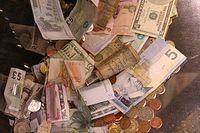Explore web search results related to this domain and discover relevant information.

In economics, cash is money in the physical form of currency, such as banknotes and coins.
The word cash comes from the Middle French caisse 'money box', which comes from the Old Italian cassa, and ultimately from the Latin capsa 'box'.[1][2] ... In Western Europe, after the fall of the Western Roman Empire, coins, silver jewelry and hacksilver (silver objects hacked into pieces) were for centuries the only form of money, until Venetian merchants started using silver bars for large transactions in the early Middle Ages.In the early part of the 17th century, English East India Company coins were minted in England and shipped to the East. In England, over time the word cash was adopted from Sanskrit कर्ष karsa,[dubious – discuss] a weight of gold or silver but akin to the Old Persian 𐎣𐎼𐏁 karsha, unit of weight (83.30 grams).In 1677 this was sanctioned by the Crown, the coins, having received royal sanction, were struck as silver rupees; the inscription runs "The rupee of Bombaim", by the authority of Charles II. Around that time, coins were also being produced for the East India Company at the Madras mint. The Tamil the word for money is kaasu,[3] which may have been modified into 'cash'.The currency at the company's Bombay and Bengal administrative regions was the rupee. At Madras, however, the company's accounts were reckoned in pagodas, fractions, fanams, faluce and cash. This system was maintained until 1818 when the rupee was adopted as the unit of currency for the company's operations.
Cash flow is the net amount of cash that an entity receives and disburses over time. Positive cash flow must be maintained for an entity to remain in business.
Cash flow is the net amount of cash that an entity receives and disburses during a period of time. A positive level of cash flow must be maintained for an entity to remain in business, while positive cash flows are also needed to generate value for investors.Cash inflows come from the sources noted below. An alternative way to calculate the cash flow of an entity is to add back all non-cash expenses (such as depreciation and amortization) to its net after-tax profit, though this approach only approximates actual cash flows.Cash inflows from operations is cash paid by customers for services or goods provided by the entity. It includes the primary revenue-generating activities of an entity, such as cash received from the sale of goods or services, royalties on the use of company-owned intellectual property, commissions for sales on behalf of other entities, and cash paid to suppliers.Cash flow from financing activities. Cash inflows from financing activities come from debt incurred by the entity. Items that may be included in financing activities are the sale of stock, issuance of debt, and donor contributions restricted to long-term use.

The European Central Bank (ECB) is the central bank of the European Union countries which have adopted the euro. Our main task is to maintain price stability in the euro area and so preserve the purchasing power of the single currency.
It ensures your freedom and autonomy. Banknotes and coins are the only form of money that people can keep without involving a third party. You don’t need access to equipment, the internet or electricity to pay with cash, meaning it can be used when the power is down or if you lose your card.For more information, see the European Commission Recommendation of 22 March 2010 on the scope and effects of legal tender of euro banknotes and coins (2010/191/EU). It ensures your privacy. Cash transactions respect our fundamental right to have our privacy, data and identity protected in financial matters.It’s inclusive. Cash provides payment and savings options for people with limited or no access to digital money, making it crucial for the inclusion of socially vulnerable citizens such as the elderly or lower-income groups.It’s secure. Cash has proven to be secure against cybercrime, fraud and counterfeiting. And, as it’s central bank money, it doesn’t entail financial risks for either the payer or the payee. It’s a store of value. Cash is more than just a payment instrument.
The use of cash for payments is not well measured. We view the value of cash withdrawn from ATMs, or as a share of all payments, as a more accurate and timely measure of cash use compared to the standard measure of currency in circulation, or as a ratio to GDP.
Tanai Khiaonarong, and David Humphrey. "Measurement and Use of Cash by Half the World’s Population", IMF Working Papers 2023, 062 (2023), accessed September 9, 2025, https://doi.org/10.5089/9798400237799.001We view the value of cash withdrawn from ATMs, or as a share of all payments, as a more accurate and timely measure of cash use compared to the standard measure of currency in circulation, or as a ratio to GDP. These two measures are compared for 14 advanced and emerging market economies.When aggregated, the trend in cash use for payments is currently falling for half the world’s population. Such a measure can help inform policy decisions regarding CBDC and regulatory decisions concerning access to and use of cash.Keywords: Access to cash, Aggregate Currency value, ATM cash, Cash, Cash use, Central bank digital currency, Currencies, Monetary base, Payment systems, Payments, Purchasing power parity, Stocks, Use of cash, Value of cash


The use of cash for payments is not well measured. We view the value of cash withdrawn from ATMs, or as a share of all payments, as a more accurate and timely measure of cash use compared to the standard measure of currency in circulation, or as a ratio to GDP.
Tanai Khiaonarong, and David Humphrey. "Measurement and Use of Cash by Half the World’s Population", IMF Working Papers 2023, 062 (2023), accessed September 9, 2025, https://doi.org/10.5089/9798400237799.001We view the value of cash withdrawn from ATMs, or as a share of all payments, as a more accurate and timely measure of cash use compared to the standard measure of currency in circulation, or as a ratio to GDP. These two measures are compared for 14 advanced and emerging market economies.When aggregated, the trend in cash use for payments is currently falling for half the world’s population. Such a measure can help inform policy decisions regarding CBDC and regulatory decisions concerning access to and use of cash.Keywords: Access to cash, Aggregate Currency value, ATM cash, Cash, Cash use, Central bank digital currency, Currencies, Monetary base, Payment systems, Payments, Purchasing power parity, Stocks, Use of cash, Value of cash
Cash is legal tender or coins that can be used to exchange goods, debt, or services. Cash in its physical form is the simplest, most broadly accepted and reliable form of payment.
He previously held senior editorial roles at Investopedia and Kapitall Wire and holds a MA in Economics from The New School for Social Research and Doctor of Philosophy in English literature from NYU. ... Michael Boyle is an experienced financial professional with more than 10 years working with financial planning, derivatives, equities, fixed income, project management, and analytics. ... Cash is legal tender, including currency and coins, that can be used for transactions and may also include easily convertible assets in a financial context.Cash is legal tender—currency or coins—that can be used to exchange goods, debt, or services. Sometimes it also includes the value of assets that can be easily converted into cash immediately, as reported by a company.Although cash typically refers to money in hand, the term can also be used to indicate money in banking accounts, checks, or any other form of currency that is easily accessible and can be quickly turned into physical cash.Cash in its physical form is the simplest, most broadly accepted and reliable form of payment, which is why many businesses only accept cash. Checks can bounce and credit cards can be declined, but cash in hand requires no extra processing.
:max_bytes(150000):strip_icc()/corruption-business-concept-corruption-concept-1133019805-66fe85117cb14ca7b92f958142c895eb.jpg)

Cash is still the second most popular payment method in the UK, accounting for 12% of all payments in 2023, with free-to-use (FTU) ATMs remaining the main channel through which most people access cash, representing 93% of all cash withdrawals in the UK in 2023.
It has given the FCA broader powers on access to cash while the Treasury’s Policy Statement set out the government’s aim for the vast majority of people in the UK to have reasonable access to cash deposit and withdrawal services within a maximum of either one mile in urban areas or three miles in rural areas.We will retain oversight of LINK, the UK’s largest ATM network which allows cardholders to withdraw cash at any ATM connected to its network, as a designated payment system under FSBRA 2013, and we will work closely with the FCA in their oversight of LINK as a designated cash access coordination body.Our latest estimates (availability of cash points - June 2023) indicate that 99.3% of the UK urban population are within one mile of an FTU cash withdrawal point, such as a cash machine or a Post Office branch, while 98.6% of the UK rural population are within three miles.We will continue to be a part of the Joint Authorities Cash Strategy (JACS) group, which ensures there’s comprehensive oversight of the UK’s cash infrastructure – including cash production and distribution, bank branches, retailer cashback and shared Banking Hubs.
Direct deposit provided by Cash App, a Block Inc. brand. Choose the most flexible way to pay over time with no hidden fees or impact to your credit score. ... Instantly send, receive, and transfer money for free. ... Prepaid debit cards issued by Sutton Bank, Member FDIC. See Terms and Conditions. ... Bitcoin services provided by Block Inc. Bitcoin services are not licensable activity in all U.S. states and territories. Block, Inc. operates in New York as Block of ...
Direct deposit provided by Cash App, a Block Inc. brand. Choose the most flexible way to pay over time with no hidden fees or impact to your credit score. ... Instantly send, receive, and transfer money for free. ... Prepaid debit cards issued by Sutton Bank, Member FDIC. See Terms and Conditions. ... Bitcoin services provided by Block Inc. Bitcoin services are not licensable activity in all U.S. states and territories. Block, Inc. operates in New York as Block of Delaware and is licensed to engage in virtual currency business activity by the New York State Department of Financial Services.If they're not already a Cash App customer, they’ll be asked to create an account and verify their phone number or email by entering a one-time passcode to accept the payment. If they don’t create their account and verify their phone number or email within 14 days, the payment gets returned to you. Only residents of the United States can create Cash App accounts.Cash App uses encryption and fraud detection technology to help keep your data and money secure. Any information you submit is encrypted and sent to our servers securely, regardless of whether you're using a public or private Wi-Fi connection or data service.Get the best parts of Cash App when you direct deposit $300 in paychecks each month.

The word cash comes from the Middle French caisse 'money box', which comes from the Old Italian cassa, and ultimately from the Latin capsa 'box'. In Western Europe, after the fall of the Western Roman Empire, coins, silver jewelry and hacksilver (silver objects hacked into pieces) were for ...
The word cash comes from the Middle French caisse 'money box', which comes from the Old Italian cassa, and ultimately from the Latin capsa 'box'. In Western Europe, after the fall of the Western Roman Empire, coins, silver jewelry and hacksilver (silver objects hacked into pieces) were for centuries the only form of money, until Venetian merchants started using silver bars for large transactions in the early Middle Ages.In the early part of the 17th century, English East India Company coins were minted in England and shipped to the East. In England, over time the word cash was adopted from Sanskrit कर्ष karsa, a weight of gold or silver but akin to the Old Persian 𐎣𐎼𐏁 karsha, unit of weight (83.30 grams).In 1677 this was sanctioned by the Crown, the coins, having received royal sanction, were struck as silver rupees; the inscription runs "The rupee of Bombaim", by the authority of Charles II. Around that time, coins were also being produced for the East India Company at the Madras mint. The Tamil the word for money is kaasu, which may have been modified into 'cash'.The currency at the company's Bombay and Bengal administrative regions was the rupee. At Madras, however, the company's accounts were reckoned in pagodas, fractions, fanams, faluce and cash. This system was maintained until 1818 when the rupee was adopted as the unit of currency for the company's operations.Its remaining role is to provide a form of currency storage and payment for those who do not wish to take part in other systems, and make small payments conveniently and promptly, though this latter role is being replaced more and more frequently by electronic payment systems. Research has found that the demand for cash decreases as debit card usage increases because merchants need to make less change for customer purchases.

4 Reporting 4.5 Statement of Cash Flows 4.5.10 The government must present a statement of cash flows for proprietary funds. The only acceptable method of presentation is the direct method. In using the direct method, a reconciliation of operating cash flows to operating income is required.
Cash outflows in the investing activities category include: Loans made to others (except for program loans). Purchase of investments.This reconciliation should be presented either within the statement of cash flows or as an accompanying schedule to the statement. Noncash investing, capital, or financing transactions · 4.5.130 The statement of cash flows is limited to actual inflows and outflow of cash (and cash equivalents).The transaction would not properly have been classified as cash flows from operating activities. This information can be presented either in a narrative or tabular format on a separate schedule accompanying the statement of cash flows.In addition, the operating activities category is used for any cash inflow or outflow that cannot properly be classified in one of the other three categories.

According to the Fed’s latest Survey of Consumer Finances, the amount held in bank accounts across all American households in 2022 (the most recent data available) was $8,000. This amount is in transaction accounts, which include checking, savings, money market, and brokerage cash accounts, ...
According to the Fed’s latest Survey of Consumer Finances, the amount held in bank accounts across all American households in 2022 (the most recent data available) was $8,000. This amount is in transaction accounts, which include checking, savings, money market, and brokerage cash accounts, as well as prepaid debit cards.High school graduates reported median savings more than three times higher than those without a diploma. College graduates had over four times the median balance of those with some college education but no degree. However much cash you have in the bank, it’s smart to make sure it’s earning more for you.Putting some money into a high-yield savings account, money market account, or certificate of deposit (CD) can help boost your savings balances. · A high-yield savings account is among the easiest places to deposit your money, giving you access to your cash anytime you need it.You’re able to determine now how much money you’ll earn when the CD matures, and some of the best CD rates—now up to 4.60% APY—are good into 2026 or beyond, regardless of what happens to interest rates in the short term. Just be sure to pick your term carefully, as you’ll be hit with an early withdrawal penalty if you cash out before the maturity date.
Creating Assets, Savings and Hope in Maryland Promoting the economic advancement of low-to-moderate income individuals and families in Baltimore and across Maryland. Individual & Family Resources Organization & Practitioner Resources Click here for current tax preparation services and resources.
Promoting the economic advancement of low-to-moderate income individuals and families in Baltimore and across Maryland. ... Starting in 2025 Marylanders may be eligible to file directly with the IRS for FREE. ... Referral Info: Clients can fill out the form on bmorefreetaxes.org and wait to be contacted. Notes: Open through September, on Tuesdays and Thursdays. ... The CASH Campaign of Maryland promotes economic advancement for low-to-moderate income individuals and families in Baltimore and across Maryland.CASH accomplishes its mission through operating a portfolio of direct service programs, building organizational and field capacity, and leading policy and advocacy initiatives to strengthen family economic stability.The CASH Campaign of Maryland (Creating Assets, Savings and Hope) is a nonprofit organization that is the result of a merger between the CASH Campaigns of Baltimore and Maryland.

If you are a DART subscriber, please log in to enable these features. Deloitte clients who are not DART subscribers may request printed copies of Roadmaps from their engagement teams. ... Consistent with common usage, cash includes not only currency on hand but demand deposits with banks or ...
If you are a DART subscriber, please log in to enable these features. Deloitte clients who are not DART subscribers may request printed copies of Roadmaps from their engagement teams. ... Consistent with common usage, cash includes not only currency on hand but demand deposits with banks or other financial institutions.Cash also includes other kinds of accounts that have the general characteristics of demand deposits in that the customer may deposit additional funds at any time and also effectively may withdraw funds at any time without prior notice or penalty. All charges and credits to those accounts are cash receipts or payments to both the entity owning the account and the bank holding it.Generally, only investments with original maturities of three months or less qualify under that definition. Original maturity means original maturity to the entity holding the investment. For example, both a three-month U.S. Treasury bill and a three-year U.S. Treasury note purchased three months from maturity qualify as cash equivalents.However, a Treasury note purchased three years ago does not become a cash equivalent when its remaining maturity is three months. Examples of items commonly considered to be cash equivalents are Treasury bills, commercial paper, money market funds, and federal funds sold (for an entity with banking operations).
We cannot provide a description for this page right now
The Curse of Cash: How Large-Denomination Bills Aid Crime and Tax Evasion and Constrain Monetary Policy [Rogoff, Kenneth S., Rogoff, Kenneth S.] on Amazon.com. *FREE* shipping on qualifying offers. The Curse of Cash: How Large-Denomination Bills Aid Crime and Tax Evasion and Constrain Monetary ...
The Curse of Cash: How Large-Denomination Bills Aid Crime and Tax Evasion and Constrain Monetary Policy [Rogoff, Kenneth S., Rogoff, Kenneth S.] on Amazon.com. *FREE* shipping on qualifying offers. The Curse of Cash: How Large-Denomination Bills Aid Crime and Tax Evasion and Constrain Monetary PolicyAdvanced countries still urgently need to stem the global flood of large paper bills―the vast majority of which serve no legitimate purpose and only enable tax evasion and other crimes―but cryptocurrencies are like $100 bills on steroids. The Curse of Cash is filled with revealing insights about many of the most pressing issues facing monetary policymakers, from quantitative easing to alternative inflation targeting regimes.It also explains in detail why, if low interest rates persist, the best way to reinvigorate monetary policy is to implement fully effective and unconstrained negative interest rates. Provocative, engaging, and backed by compelling original arguments and evidence, The Curse of Cash has sparked widespread debate and its ideas have moved to the center of financial and policy discussions.As Kenneth Rogoff has done before, this book sets the standard on a problem that will only become more important; it is also sure to influence discussions about the ability of central banks to deliver growth and financial stability. This is a must-read."--Mohamed El-Erian, author of The Only Game in Town: Central Banks, Instability, and Avoiding the Next Collapse · "Should we become a largely cashless society?

Cash Is Alive: How Economists Explain Holding and Use of Cash by Oz Shy. Published in volume 61, issue 4, pages 1465-1520 of Journal of Economic Literature, December 2023, Abstract: Research on holding and use of cash involves many aspects, such as reasons for holding and hoarding cash, ...
Cash Is Alive: How Economists Explain Holding and Use of Cash by Oz Shy. Published in volume 61, issue 4, pages 1465-1520 of Journal of Economic Literature, December 2023, Abstract: Research on holding and use of cash involves many aspects, such as reasons for holding and hoarding cash, transactiona...(December 2023) - Research on holding and use of cash involves many aspects, such as reasons for holding and hoarding cash, transactional demand for cash, cash management, type of spending paid with cash, type of consumer who pays cash, merchant acceptance, how consumers get cash, currency denominations, legal aspects, cash substitutes, and cost of cash.The purpose of this article is to introduce the reader to some of the research economists do on consumer holding and use of cash.Shy, Oz. 2023. "Cash Is Alive: How Economists Explain Holding and Use of Cash." Journal of Economic Literature 61 (4): 1465–1520.

What is cash on hand? The definition of cash on hand is the amount of accessible cash a business has after paying all its costs. Generally, it includes any assets you can liquidate into cash in less than 90 days. It does not include money the business cannot spend, such as the minimum deposit ...
What is cash on hand? The definition of cash on hand is the amount of accessible cash a business has after paying all its costs. Generally, it includes any assets you can liquidate into cash in less than 90 days. It does not include money the business cannot spend, such as the minimum deposit required to keep a bank account open.Having cash on hand allows a company to pay rent, operating costs, and vendors if the business’s income stream slows down. Depending on the type of business, it’s advisable to have three to six months of operating expenses on hand. Some businesses experience seasonal ebbs and flows and need to increase their cash on hand accordingly.Another one of the advantages of having cash on hand is that it allows your company to seize on investment opportunities without having to wait for financing or incur debt liability. But if a chance to expand your business comes along, you must weigh the opportunity costs against the risk of depleting your cash on hand.If your cash flow statement shows you have enough cash on hand to keep your business running normally for a significant period of time, potential investors, partners, or customers likely will view your business as a healthy one.

Cash App is a peer-to-peer payment service with plenty of other features, such as saving and investing, to help you meet your financial goals.
We earn a commission from affiliate partners on many offers and links. This commission may impact how and where certain products appear on this site (including, for example, the order in which they appear). Read more about Select on CNBC, and click here to read our full advertiser disclosure. ... ShareShare Article via FacebookShare Article via TwitterShare Article via LinkedInShare Article via Email · Cash might be king but its kingdom looks more and more digital.Cash App is a financial platform providing services through its bank partners, Lincoln Savings Bank and Sutton Bank. It also offers investing services through Cash App Investing LLC, which is a registered broker-dealer and a Financial Industry Regulatory Authority (FINRA) member.The service, available as an app for iOS and Android, allows users to easily send, receive and invest money — among many other functions. From saving to filing taxes, Cash App continues to expand its pool of features.Money transfers: Users can send and receive money, as well as transfer the money they have in their Cash App account to a linked bank account. Sending and receiving money is free. Standard transfers also charge no fees and take one to three business days to complete. An instant transfer is also an option, but it costs 0.50% to 1.75% of the transfer amount, with a minimum fee of $0.25.

Cash App is a mobile payment application that enables individuals to send and receive money instantly using just their phone. In the most simple terms, it is a quick and convenient method to pay a friend back for dinner, split rent with a flatmate, or wish someone a happy birthday by sending a present without carrying a bunch of ...
Cash App is a mobile payment application that enables individuals to send and receive money instantly using just their phone. In the most simple terms, it is a quick and convenient method to pay a friend back for dinner, split rent with a flatmate, or wish someone a happy birthday by sending a present without carrying a bunch of cash or even without knowing a person's bank account number.The best thing about the Cash App is that it is incredibly minimal and quick. You enter a sum of money, choose someone on your contacts list, and send or receive money. It does not take long, and there is no need to visit a bank all the time. All of this occurs within the app, most often in seconds.When money is in your Cash App balance, you can use it with the Cash Card, a customizable debit card connected directly to your app balance. It was created by Block, Inc. (formerly Square), and the target audience of the app includes individuals who need to conduct small money transfer activities without any friction and in a fast manner.In case you have ever found yourself in a scenario where you owe somebody money or need to divide a bill quickly, Cash App allows you to do so without any pain. It’s convenient mostly in cases when you do not want to carry cash with you or to request the bank details of a person.

Let’s talk about cash. It might not be the most exciting part of your portfolio, but it’s absolutely essential. I often find that people either hold too much cash or not nearly enough.
Here are four essential rules for effective cash management, from building the right emergency fund to knowing where to park your money and when to invest excess cash. The foundation of smart cash management is an emergency fund. This should cover your essential living expenses, such as housing, food, and utilities, for three to six months.Once you’ve satisfied your emergency fund and short-term goals, any cash beyond that should be invested in a portfolio structured according to your personal risk tolerance and long-term financial plan. The key is to strike a balance. You want enough cash to meet your immediate needs and provide peace of mind, but you don’t want so much that it hinders your ability to grow your wealth over the long term.If you have cash holdings that exceed these limits, you may want to consider spreading your money across multiple banks to ensure full coverage. Alternatively, you could explore other options like brokered CDs, which can sometimes offer higher insurance limits.Holding excessive cash can be a drag on your overall investment returns. While cash provides stability and liquidity, it typically earns very little, especially in periods of low interest rates.

:max_bytes(150000):strip_icc()/corruption-business-concept-corruption-concept-1133019805-66fe85117cb14ca7b92f958142c895eb.jpg)


